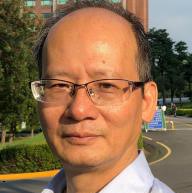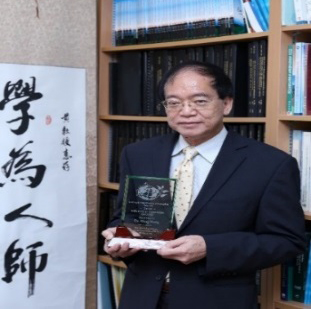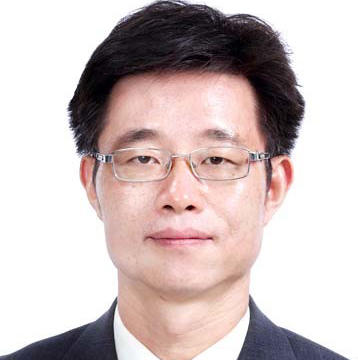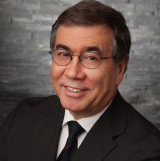Keynote Speakers
Prof. Dr. Chih-Huang Weng
Professor, Department of Civil Engineering, I-Shou UniversitySpeech Title: Energy- and Materials-activated Persulfate Processes for Degradation of Organic Contaminants
Abstract: Advanced oxidation processes (AOPs) using strong oxidizing radicals, mainly sulfate (SO4•–) and hydroxyl radicals (HO•), are frequently studied for degradation of refractory organic contaminants. Among the AOPs process, persulfate (PS) activation technology has gained considerable attention for removal of organic contaminants owing to its superior oxidant power, high stability at room temperature, having a much longer lifetime of reactivity compared with HO• radicals, and maintaining reactive over a wide range of pH. Peroxydisulfate (S2O82–, PDS) and peroxymonosulfate (HSO5–, PMS, monopersulfate) are commonly used in generating SO4•– radicals. PDS has a better potential for application over PMS due to its stability, long environmental retention time, and low cost. The effectiveness of PS activation technology is depending upon the activation methods. This presentation highlights the ways employed for activation of PS to generate SO4•–, including base activation, energy (electrical) activation, and materials activation. Energy-based activation, i.e., heat, ultrasound, microwave, and ultraviolet light, are commonly used for initiating the formation of SO4•– radicals. A materials-based activation consumes less energy and requires simpler reactor configuration as compared to the energy-based activation. Carbon-based materials and transition metals are frequently used as activators. Soil organic matters and glucose can also activate the persulfate. Such practices are quite interest in the in situ chemical oxidation of contaminated soils and groundwater. The newly developed magnetic materials, such as nFe3O4/biochar, magnetic Fe3O4/montmorillonite, Fe3O4-α-MnO2, and γ-Fe2O3/Mn3O4 nanocomposites is briefly introduced in terms of their effectiveness and practical applicability. This presentation also of particular focuses on PS activation via nano-sized Fe0 (nZVI), Fe0 aggregates, and Fe-containing minerals (biotite, tourmaline, pyrite, mackinawite, and greigite). Of particular interest is the feasibility of using ultrasound and heat as enhancement tools in the activated-PS system. The indispensable operating factors affecting such process is discussed and further exemplified by studies of degradation of azo dyes. Generally, a pseudo-first-order reaction kinetic model is adopted to characterize the rate of degradation. This presentation provides an overview of PS-based AOPs for contaminant removal from aqueous solution and particularly for the understanding of the activation methods, influential parameters, and enhancement tools in the application of this technology.
Biography: Dr. Chih-Huang Weng is a Full Professor in the Department of Civil and Ecological Engineering at I-Shou University, Taiwan. He also serves as Vice President of North Kaohsiung Community University, Kaohsiung City. He received his MS and Ph.D. degrees in 1990 and 1994, respectively, from the Department of Civil Engineering of The University of Delaware, USA. He has published around 90 papers in SCI journals and 36 of them H-index with 4336 citations in Mendeley database. He serves as the editor, editorial board member, and guest editor of several academic journals, such as Agricultural Water Management, Coloration Technology, Environmental Geochemistry and Health, and Environmental Science and Pollution Research. He has also organized and chaired several international conferences. His main research interests focus on using advanced oxidation processes and adsorption for the treatment of wastewater and bacteria inactivation, ground water modeling, and application of electrokinetic technologies to soil remediation/sludge treatment/activated carbon regeneration.
Prof. Ming-Hung Wong
Research Chair Professor of Environmental Science, The Education University of Hong KongDistinguished Visiting Professor, School of Environmental Science and Engineering, Southern University of Science and Technology
Speech Title: Ecological and health impacts of plastics and microplastics, with a focus on chemical toxicity
Abstract: A wide range of persistent and toxic chemicals is generated through the use of various consumer products: pharmaceuticals and personal care products (PCPPs), detergents, disinfectants, plasticizers, preservatives, microplastics, and nanomaterials, etc. [1,2]. These chemicals and their metabolites can be found in different environmental media, including wastewater, agricultural and urban runoff, lakes, rivers, ground water and drinking water. The conventional wastewater and (drinking) water treatment processes are not always efficient in removing them [3-6]. Some of these potent chemicals may enter the food chain, posing health threats, mainly through consumption of contaminated seafood [7]. The major objectives of this presentation are to review the current status on the sources, fates and health effects of some major emerging chemicals of concern, with emphasis on phthalates [8,9], bisphenol A [10], perfluorooctane sulfonate (PFOS) [11], and PCPPs [12], citing some local examples in South China (including Hong Kong). It is also intended to review the exposure pathways of these chemicals, and their potential associations with body loadings and associated health effects. It is known that autism spectrum disorders in children is related to exposure to various environmental pollutants [13]. These endocrine disrupting chemicals such as bisphenol A and phthalates are widely detected in indoor dust [14,15], food items such as fish [16-19] and meat [20], and blood plasma of local residents [21]. Nevertheless, there seems to be an urgent need to study the potential toxic effects of microplastics (particle size smaller than 5 mm), including those derived from PCPPs, as they are now widely distributed in the coastal environment, and their uptake mechanisms by fish, and the long-term health impacts on consumers are largely unknown. It seems essential to manage these emerging chemicals of concern more effectively, both nationally and internationally [1].
Key words: phthalates, bisphenol A, microplastics, exposure pathways, toxicity.
References
[1] Wong MH, Armour MA, Naidu R, Man M (2012). Persistent toxic substances: sources, fates and effects. Rev Environ Health 27: 207-13.
[2] Bouwman H, Wong MH, Barra R (2012). GEF Guidance on Emerging Chemicals Management Issues in Developing Countries and Countries with Economy in Transition. UNEP/GEF.
[3] Man M, Wong MH (2012) Removal of persistent organic pollutants (POPs) and compounds of emerging concern (CECs) in public owned sewage treatment works (POSTW) – a review. In: Environmental Contamination – Health Risks and Ecological Restoration. Wong MH (Ed) Taylor and Francis/CRC, London.
[4] Man YB, Chow KL, Man M, Lam JCW, Lau FTK, Fung WC, Wong MH (2015). Profiles and removal efficiency of polybrominated diphenyl ethers by two different types of sewage treatment work in Hong Kong. Sci Total Environ 505: 261-68.
[5] Chow KL, Man YB, Tam NFY, Liang Y, Wong MH (2017). Removal of decabromodiphenyl ether (BDE-209) using a combined system involving TiO 2 photocatalysis and wetland plants. J Hazard Mater 322: 263-9.
[6] Man, YB, Chow KL, Tsang YF, Lau FTK, Fung WC, Wong, MH, (2018). Fate of bisphenol A, perfluorooctanoic acid and perfluorooctanesulfonate in two different types of sewage treatment works in Hong Kong. Chemosphere, 190: 358-367.
[7] Wong MH (2017). Chemical pollution and seafood safety, with a focus on mercury: The case of Pearl River Delta, South China. Environ Technol Innov 7:63-76.
[8] Lü H, Mo CH, Zhao HM, Xiang L, Katsoyiannis A, Li YW, Cai QY, Wong MH (2018). Soil contamination and sources of phthalates and its health risk in China: A review. Environ Res 164: 417-29.
[9] Wang W, Leung AOW, Chu LH, Wong MH (2018). Phthalates contamination in China: Status, trends and human exposure – with emphasis on oral intake. Environ Pollut 238: 771-782.
[10] Huang YQ, Wong CKC, Zheng JS, Bouwman H, Barra R, Wahlstrom B, Neretin L, Wong MH (2012). Bisphenol A (BPA) in China: A review of sources, environmental levels, and potential human health impacts. Environ Int 42: 91-9.
[11] Zhao YG, Wong CKC, Wong MH (2012). Environmental contamination, human exposure and body loadings of perfluorooctane sulfonate (PFOS), focusing on Asian countries. Chemosphere 89: 355-68.
[12] Liu JL, Wong MH (2013). Pharmaceuticals and personal care products (PPCPs): A review on environmental contamination in China. Environ Int 59: 208-24.
[13] Ye BS, Leung AOW, Wong MH (2017). The association of environmental toxicants and autism spectrum disorders in children. Environ Pollut 227: 234-42.
[14] Kang Y, Man YB, Cheung KC, Wong MH (2012). Risk assessment of human exposure to bioaccessible phthalate esters via indoor dust around the Pearl River Delta. Environ Sci Technol 46: 8422-30
[15] Wang W, Wu FY, Huang MJ, Kang Y, Cheung KC, Wong MH (2013). Size fraction effect on phthalate esters accumulation, bioaccessibility and in vitro cytotoxicity of indoor/outdoor dust, and risk assessment of human exposure. J Hazard Mater 261: 753-62.
[16] Cheng Z, Nie XP, Wang HS, Wong MH (2013). Risk assessments of human exposure to bioaccessible phthalate esters through market fish consumption. Environ Int 57-58: 75-80.
[17] Cheng Z, Li HH, Wang HS, Zhu XM, Sthiannopkao S, Kim KW, Yasin MSM, Hashim JH, Wong MH (2016). Dietary exposure and human risk assessment of phthalate esters based on total diet study in Cambodia. Environ Res 150: 423-30.
[18] Wei X, Huang YQ, Wong MH, Giesy JP, Wong CKC (2011). Assessment of risk to humans of bisphenol A in marine and freshwater fish from Pearl River Delta, China. Chemosphere 85:122-8.
[19] Zhao YG, Wan HT, Law AYS, Wei X, Huang YQ, Giesy J, Wong MH, Wong CKC (2011). Risk assessment for human consumption of perfluorinated compound-contaminated freshwater and marine fish from Hong Kong and Xiamen. Chemosphere 85: 277-83.
[20] Law AYS, Wei X, Zhang XW, Mak NK, Cheung KC, Wong MH, Giesy J, Wong CKC (2011). Biological analysis of endocrine-disrupting chemicals in animal meats from the Pearl River Delta, China. J Expo Sci Environ Epidemiol 22: 93-100.
[21] Wan HT, Leung PY, Zhao YG, Wei X, Wong MH, Wong CKC (2013). Blood plasma concentrations of endocrine disrupting chemicals in Hong Kong populations. J Hazard Mater 261: 763-9.
Biography: Prof. Wong is currently Advisor and Research Chair Professor of Environmental Science, The Education University of Hong Kong, and Distinguished Visiting Professor of School of Environmental Science and Engineering, Southern University of Science and Technology, Shenzhen, China. His research areas included environmental and health risk assessments of persistent toxic substances, ecological restoration of contaminated sites, and recycling of organic wastes, with a focus on upgrading food wastes as fish feeds. He has published over 690 SCI papers and 32 book chapters, edited 25 books/special issues of scientific journals, and has successfully filed 5 patents. A recent exercise assessing papers published 1996-2018, based on Scopus: citation, H-index, Hm-index, etc.; Prof. Wong ranked 24, and the most cited Chinese scientist worldwide, under Environmental Science (Sept., 2019).
Prof. Wong served as the Coordinator of Central and North-East Asia of the project “Regionally based assessment of Persistent Toxic Substances”, and as a Panel Member (of three experts) of another project “Chemicals Management Issues of developing countries and countries with economies in transition”, both sponsored by UNEP/GEF, during 2001-2003, and 2010-2012, respectively.
Prof. Zhimin Qiang
Professor/Director, Key Laboratory of Drinking Water Science and Technology, Research Center for Eco-Environmental Sciences, Chinese Academy of SciencesSpeech Title: Drinking Water Safety in China: Standards, Problems and Countermeasures
Abstract: Drinking water is directly related to human health, which is one of the major livelihood issues concerned by governments all over the world. In the whole system of water environment protection and remediation, drinking water safety always occupies the most important and core status. At present, about 1.2 billion people in the world do not have access to clean drinking water and about 2.6 billion people lack safe sanitation facilities of drinking water. Therefore, drinking water safety has become a major environmental and health problem internationally.
This report first discusses the advantages and gaps of drinking water standards in China through comparison with those issued by international organizations and developed countries such as World Health Organization (WHO), United States, European Union, and Japan. Second, the main problems of drinking water safety in China are summarized as follows: imperfect drinking water standards, conventional treatment processes being still dominant in water treatment plants, difficulties in water quality maintenance and leakage control in pipe networks, insufficient water quality monitoring and detection capabilities, and weak foundation for rural drinking water safety. Third, the main technical countermeasures are put forward from all aspects of drinking water safety: water quality risk assessment methods, water source ecological improvement, novel water purification processes, and safe water distribution of pipe networks. Finally, future prospects are proposed concenring the control of emerging contaminants and combined pollution effect as well as the development of green water treatment technologies and information management platforms.
Keywords: Drinking water safety; Standards; Problems; Countermeasures; Prospects
Biography: Prof. Qiang is currently Director of the Key Laboratory of Drinking Water Science and Technology, Chinese Academy of Sciences, and a registered Professional Engineer in Ohio, USA. He received his BS (1994) and MS (1997) from Tongji University and PhD (2002) from the University of Delaware. Then he worked from Postdoctoral Fellow to Research Associate Professor at the Missouri University of Science and Technology. In 2006, he joined the Research Center for Eco-Environmental Sciences, Chinese Academy of Sciences, as an overseas outstanding scholar. He leads a research team focusing on emerging contaminants control, water advanced treatment and disinfection, and water distribution system leakage control and optimized operation. He has published more than 220 research papers (including 42 ES&T and Water Res. papers), and been authorized 9 invention patents. He was awarded the IWA East Asia Regional Project Innovation Award (2014), Distinguished Young Scholar of the National Natural Science Foundation of China (2015), Beijing Science and Technology Award (2015), and Huaxia Construction Science and Technology Award (2018).
Prof. Rolf Katzenbach
Director of the Institute and Laboratory of Geotechnics of Technische Universität Darmstadt, Germany (1993-2018)CEO of Consulting Office “Ingenieursozietät Professor Dr.-Ing. Katzenbach GmbH”
Publicly certified Expert
Speech Title: Realistic Modelling of Soil Structure Interaction for the environmental friendly-Foundation of the highest High-Rise Buildings of the World: Theory and Practice
Abstract: An optimised and safe design of foundation systems for high-rise buildings in difficult soil and groundwater conditions is based on a reduction of construction material used, construction time spent, energy consumed and the adequate consideration of the soil-structure interaction. For high-rise buildings the following aspects are the basis for an environment friendly and safe design:
- adequate soil investigation
- in-situ load tests of (deep) foundation elements
- advanced foundation systems like the Combined Pile-Raft Foundation (CPRF)
- non-linear numerical simulations (e.g. Finite-Element-Method)
- observational method including in-time detection
- independent peer review (4-eye-principle)
Considering these aspects, the planning, design and construction of the highest high-rise buildings in the world have been successful, e.g. the Jeddah Tower in Jeddah in Saudi Arabia (1,007 m high), the Federation Tower in Moscow in Russia (360 m high) and the Commerzbank in Frankfurt am Main in Germany (299 m high). Figure 1 shows the three high-rise buildings.

Fig. 1. Jeddah Tower (left), Federation Tower (middle), Commerzbank (right).
All these examples are founded in difficult soil and groundwater conditions and for each a special foundation system was developed.
In the presentation the principle of environment friendly and sustainable foundation systems is explained, including the knowledge about the hybrid foundation system CPRF. In addition, several examples from engineering practice are shown.
Biography: Professor Dr.-Ing. Rolf Katzenbach was from 1993 until 2018 Director of the Institute and Laboratory of Geotechnics of Technische Universität Darmstadt, Germany, and is CEO of his Consulting Office "Ingenieursozietät Professor Dr.-Ing. Katzenbach GmbH". He is Past-Chairman of TC 212 Deep Foundations of the International Society for Soil Mechanics and Geotechnical Engineering (ISSMGE) and Board Member of several other international and national organizations.
He is member of the Chamber of Engineers and publicly certified official Expert of Geotechnics and Independent Checking Engineer working with his expertise for national and international courts of justice, the International Chamber of Commerce (ICC, Paris) arbitration committees, insurance companies, state ministries, building authorities and big national and international financial institutions and investors.
Professor Katzenbach is involved in a lot of national and international projects, regarding value engineering and the safety and serviceability of buildings and structures. Due to his outstanding expertise and knowledge Professor Katzenbach was appointed by the Building and Construction Authority (BCA) Singapore to carry out the independent Peer Review for the new Metro Line DLH3 in Singapore. The Kingdom of Saudi Arabia appointed Professor Katzenbach to check the safety of the foundation of the 1,007 m high Jeddah Tower (former name: Kingdom Tower) in Jeddah which is currently the highest high-rise building of the world.
Professor Katzenbach is responsible for the successful application of the Combined Pile-Raft Foundation (CPRF) at important projects all over the world and is a respected specialist for soil and rock mechanics, retaining systems, slope stability and underground constructions, including tunnels for railway lines and metro systems.



